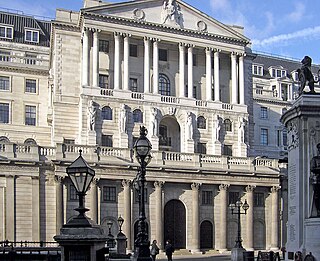A lien is a form of security interest granted over an item of property to secure the payment of a debt or performance of some other obligation. The owner of the property, who grants the lien, is referred to as the lienee and the person who has the benefit of the lien is referred to as the lienor or lien holder.
A mortgage is a legal instrument of the common law which is used to create a security interest in real property held by a lender as a security for a debt, usually a mortgage loan. Hypothec is the corresponding term in civil law jurisdictions, albeit with a wider sense, as it also covers non-possessory lien.
A transaction account, also called a checking account, chequing account, current account, demand deposit account, or share draft account at credit unions, is a deposit account held at a bank or other financial institution. It is available to the account owner "on demand" and is available for frequent and immediate access by the account owner or to others as the account owner may direct. Access may be in a variety of ways, such as cash withdrawals, use of debit cards, cheques (checks) and electronic transfer. In economic terms, the funds held in a transaction account are regarded as liquid funds. In accounting terms, they are considered as cash.
Hypothec, sometimes tacit hypothec, is a term used in civil law systems or mixed legal systems to refer to a registered non-possessory real security over real estate, but under some jurisdictions it may sometimes also denote security on other collaterals such as securities, intellectual property rights or corporeal movable property, either ships only as opposed to other movables covered by a different type of right (pledge) in the legal systems of some countries, or any movables in legal systems of other countries. The common law has two equivalents to the term, namely mortgage and non-possessory lien.

In finance, a security interest is a legal right granted by a debtor to a creditor over the debtor's property which enables the creditor to have recourse to the property if the debtor defaults in making payment or otherwise performing the secured obligations. One of the most common examples of a security interest is a mortgage: a person borrows money from the bank to buy a house, and they grant a mortgage over the house so that if they default in repaying the loan, the bank can sell the house and apply the proceeds to the outstanding loan.
The maritime lien is one of three in rem claims capable of being brought under UK Admiralty Law. Whilst being a common law instrument, it has been codified under s.21(3) of the Senior Courts Act 1981 along with s.21(2) and s.21(4), its statutory counterparts. Maritime lien and ship mortgage have a single corresponding term in the civil law, namely the ship hypothec.
In law, set-off or netting are legal techniques applied between persons or businesses with mutual rights and liabilities, replacing gross positions with net positions. It permits the rights to be used to discharge the liabilities where cross claims exist between a plaintiff and a respondent, the result being that the gross claims of mutual debt produce a single net claim. The net claim is known as a net position. In other words, a set-off is the right of a debtor to balance mutual debts with a creditor.
Tacking is a legal concept arising under the common law relating to competing priorities between two or more security interests arising over the same asset. The concept is best illustrated by way of example.
- Bank A lends a first advance to the borrower, which is secured by a mortgage over the borrower's property. The mortgage is expressed to secure this advance and any future advances.
- Bank B subsequently lends more money to the borrower and takes a second ranking mortgage over the same property.
- Bank A then subsequently lends a second advance to the borrower, relying on its original mortgage.
Bank regulation in the United States is highly fragmented compared with other G10 countries, where most countries have only one bank regulator. In the U.S., banking is regulated at both the federal and state level. Depending on the type of charter a banking organization has and on its organizational structure, it may be subject to numerous federal and state banking regulations. Apart from the bank regulatory agencies the U.S. maintains separate securities, commodities, and insurance regulatory agencies at the federal and state level, unlike Japan and the United Kingdom. Bank examiners are generally employed to supervise banks and to ensure compliance with regulations.

A bank is a financial institution that accepts deposits from the public and creates a demand deposit while simultaneously making loans. Lending activities can be directly performed by the bank or indirectly through capital markets.
United Kingdom banking law refers to banking law in the United Kingdom, to control the activities of banks.
Re Bank of Credit and Commerce International SA [1998] AC 214 is a UK insolvency law case, concerning the taking of a security interest over a company's assets and priority of creditors in a company winding up.

Financial law is the law and regulation of the commercial banking, capital markets, insurance, derivatives and investment management sectors. Understanding financial law is crucial to appreciating the creation and formation of banking and financial regulation, as well as the legal framework for finance generally. Financial law forms a substantial portion of commercial law, and notably a substantial proportion of the global economy, and legal billables are dependent on sound and clear legal policy pertaining to financial transactions. Therefore financial law as the law for financial industries involves public and private law matters. Understanding the legal implications of transactions and structures such as an indemnity, or overdraft is crucial to appreciating their effect in financial transactions. This is the core of financial law. Thus, financial law draws a narrower distinction than commercial or corporate law by focusing primarily on financial transactions, the financial market, and its participants; for example, the sale of goods may be part of commercial law but is not financial law. Financial law may be understood as being formed of three overarching methods, or pillars of law formation and categorised into five transaction silos which form the various financial positions prevalent in finance.

Banque Belge pour L’Etranger v Hambrouck [1921] 1 KB 321 is an English trusts law case concerning the common law remedies for receipt of trust property.

United Dominions Trust Ltd v Kirkwood [1966] 2 QB 431 was a decision of the Court of Appeal relating to what constitutes "banking business" as a matter of English law.

National Westminster Bank Ltd v Halesowen Presswork & Assemblies Ltd [1972] AC 785 is a decision of the House of Lords in relation to a banker's right to combine accounts under English law. It is the leading English case and a banker's right to combine accounts, and also an important decision relating to insolvency set-off.

Under English law, a bank has a general right to combine accounts where a customer has multiple accounts with the same bank. The right has been recognised since at least 1860. However it was not until 1975 in the House of Lords decision in National Westminster Bank Ltd v Halesowen Presswork & Assemblies Ltd [1972] AC 785 that it was finally determined that this was a type of set-off right rather than anything related to the banker's lien. Typically the right will be exercised where one account is overdrawn and the other is in credit so that the bank can secure full repayment of overdraft without the need to take any further action with respect to the customer. The broad rationale is that separate numbered accounts are set up for administrative convenience only, but the legal duty upon a bank to "account" to its customers for the sums held by it only extends to the net sum.

Joachimson v Swiss Bank Corporation [1921] 3 KB 110 is a judicial decision of the Court of Appeal of England and Wales in relation to the fundamental nature of the legal relationship between banker and customer. Together with Foley v Hill (1848) 2 HLC 28 it forms part of the foundational cases relating to English banking law and the nature of a bank's relationship with its customer in relation to the account.

Foley v Hill (1848) 2 HLC 28, 9 ER 1002 is a judicial decision of the House of Lords in relation to the fundamental nature of a bank account. Together with Joachimson v Swiss Bank Corporation [1921] 3 KB 110 it forms part of the foundational cases relating to English banking law and the nature of a bank's relationship with its customer in relation to the account.

Barclays Bank plc v Quincecare Ltd [1992] 4 All ER 363 is a judicial decision of High Court of Justice of England and Wales in relation to the banker-customer relationship, and in particular in connection with the bank's duties in relation to payment instructions which give rise, or ought to give rise, to a suspicion of fraud.








